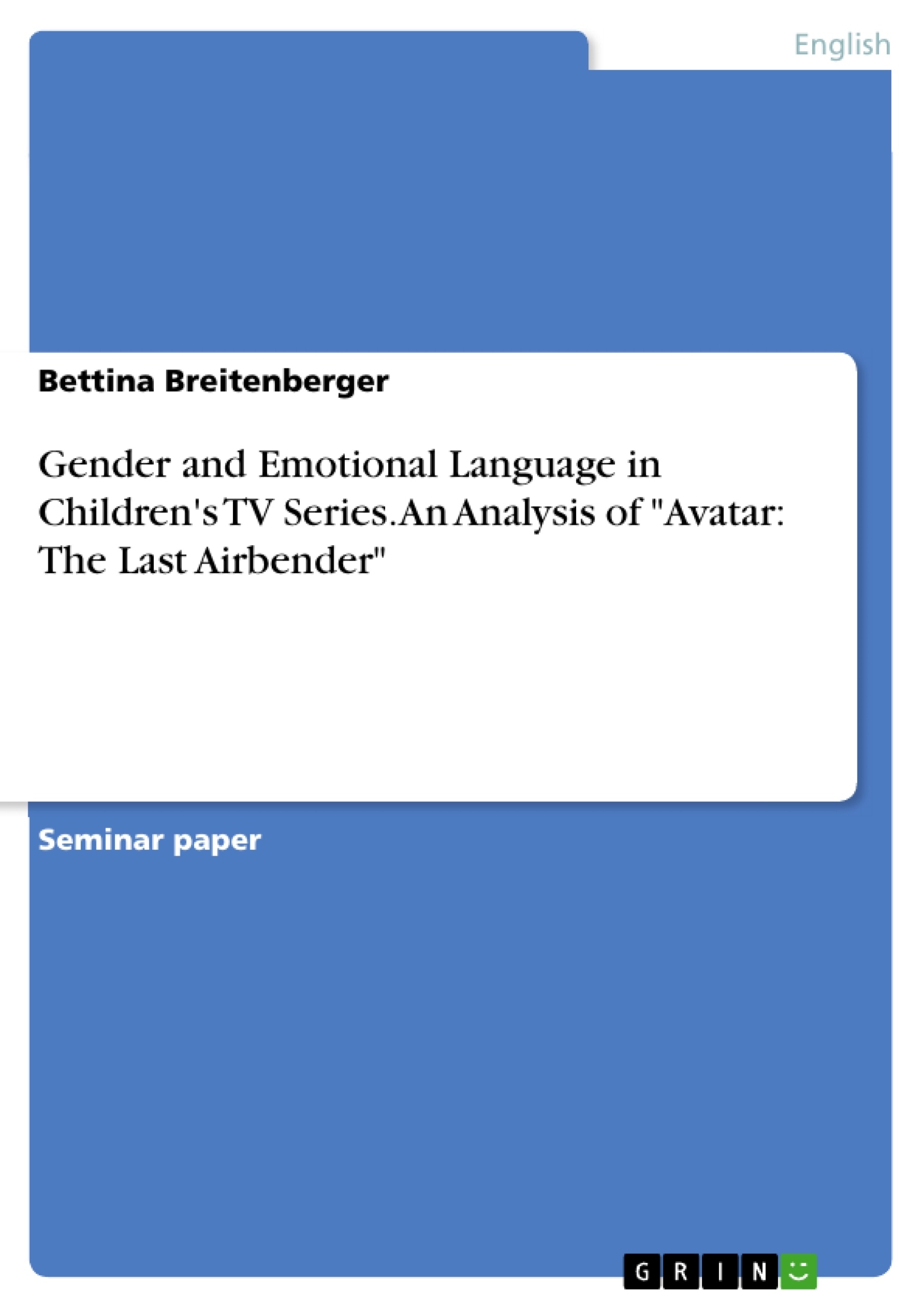As TV series can have a big impact on children's development, it is the purpose of this term paper to examine, whether gender-specific stereotypes in regard to emotions can actually be found, or whether the claim that TV series are stereotyped is a prejudice itself. Therefore, the characters' emotional language in "Avatar: The Last Airbender" will be analyzed. It will be closely looked at, whether both genders are associated with differing types and amounts of emotion talk.
Due to the results of several researchers, it was expected that female and male characters display emotions considered appropriate for their sex in order to provide children with idealized gender role models to imitate. As research sees a relationship between showing gender-conform emotions and popularity among peers, it was furthermore anticipated that fans of the series would vote those characters most popular that show emotions considered appropriate for their sex.
Inhaltsverzeichnis
- Abstract
- 1 TV Series and their Impact on Socialization
- 2 Gender-Specific Emotions
- 2.1 Stereotypes
- 2.2 Research Results
- 3 Method
- 4 Talking about Emotions
- 4.1 Fear
- 4.1.1 Direct Expressions of Fear
- 4.1.2 Indirect Expressions of Fear
- 4.1.3 Sensing Fear in Others
- 4.2 Love
- 4.2.1 Direct Expressions of Love
- 4.2.2 Indirect Expressions of Love
- 4.2.3 Sensing Love in Others
- 4.2.4 The Boys' Love Stories
- 4.3 Happiness and Joy
- 4.3.1 Direct and Indirect Expressions of Happiness and Joy
- 4.3.3 Expectation of Showing Happiness
- 4.4 Sadness
- 4.5 Anger
- 4.5.1 Direct and Indirect Expressions of Anger
- 4.5.2 Sensing Anger in Others
- 4.6 Pride
- 4.7 Summary: Non-Stereotypic Representation of Emotions
- 5 Popularity of Characters
- 6 Conclusion
- Bibliography
- Primary Sources
- Secondary Sources
- Table of Figures
- Appendices
- I Fear
- I a) Direct Expressions of Fear
- II b) Indirect Expressions of Fear
- III c) Sensing Fear in Others
- II Love
- II a) Direct Expressions of Love
- II b) Indirect Expressions of Love
- II c) Sensing Love in Others
- II d) The Boys' Love Stories
- III Happiness and Joy
- III a) Direct and Indirect Expressions of Happiness and Joy
- III b) Expectation of Showing Happiness
- IV Sadness
- V Anger
- V a) Direct and Indirect Expressions of Anger
- V b) Sensing Anger in Others
- VI Pride
Zielsetzung und Themenschwerpunkte
This term paper aims to analyze the stereotypes regarding gender and emotional language in the children's TV series Avatar: The Last Airbender. Based on previous research, it was expected that female and male characters would display emotions considered appropriate for their sex, providing children with idealized gender role models to imitate. As research suggests a relationship between showing gender-conform emotions and popularity among peers, it was further anticipated that fans of the series would vote those characters most popular who show emotions considered appropriate for their sex.
- The impact of children's TV series on socialization and gender role models.
- Stereotypes regarding gender and emotional language.
- The analysis of emotional language in Avatar: The Last Airbender.
- The relationship between emotional expression and character popularity.
- The potential for children's TV series to offer non-stereotypical gender role models.
Zusammenfassung der Kapitel
The first chapter explores the influence of children's TV series on socialization, highlighting how early exposure to media can shape children's understanding of gender-specific emotions. The second chapter delves into the existing stereotypes surrounding gender and emotional language, drawing on research findings that suggest a connection between gender conformity and popularity among peers.
The third chapter outlines the methodology used to analyze the emotional language of characters in Avatar: The Last Airbender. The fourth chapter presents the results of this analysis, examining the expression of emotions like fear, love, happiness, sadness, anger, and pride across different genders. The chapter also explores the potential for non-stereotypical representation of emotions within the series.
The fifth chapter compares the popularity of the series' main characters with the results of the emotional language analysis, investigating whether characters who display gender-conform emotions are more popular than those who do not. The sixth chapter concludes the analysis, discussing the findings, their potential impact, and further research questions.
Schlüsselwörter
The keywords and focus themes of the text include gender stereotypes, emotional language, children's TV series, Avatar: The Last Airbender, socialization, gender role models, emotional expression, character popularity, and non-stereotypical representation.
- Quote paper
- Bettina Breitenberger (Author), 2013, Gender and Emotional Language in Children's TV Series. An Analysis of "Avatar: The Last Airbender", Munich, GRIN Verlag, https://www.grin.com/document/283112
-

-

-

-
Upload your own papers! Earn money and win an iPhone X. -

-
Upload your own papers! Earn money and win an iPhone X. -

-
Upload your own papers! Earn money and win an iPhone X. -

-
Upload your own papers! Earn money and win an iPhone X. -

-
Upload your own papers! Earn money and win an iPhone X. -

-
Upload your own papers! Earn money and win an iPhone X. -

-
Upload your own papers! Earn money and win an iPhone X. -

-
Upload your own papers! Earn money and win an iPhone X. -

-
Upload your own papers! Earn money and win an iPhone X. -

-
Upload your own papers! Earn money and win an iPhone X.

